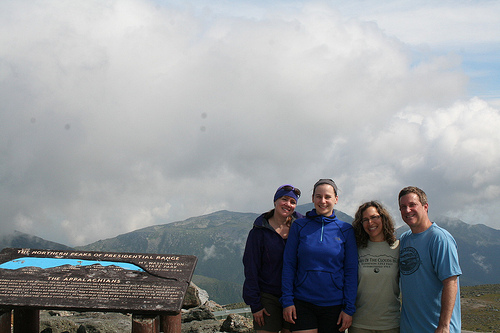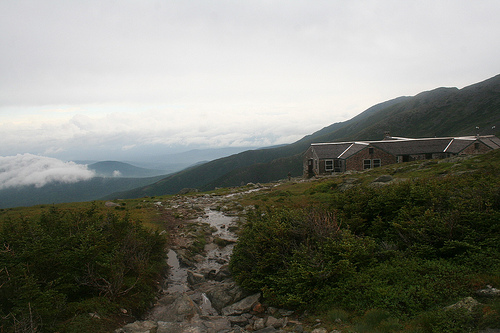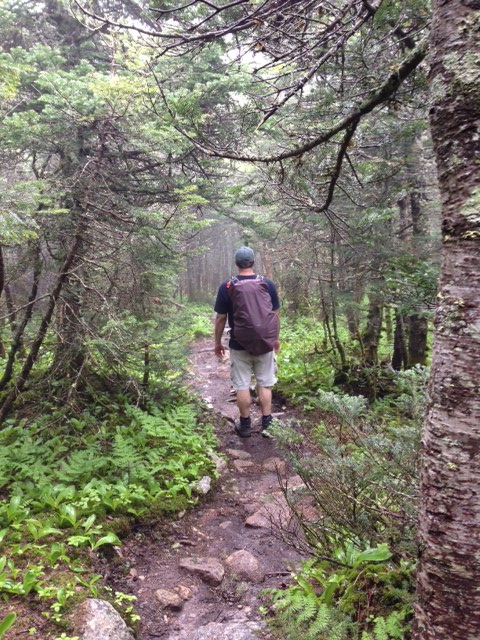
"You do not have to be good.
You do not have to walk on your knees
For a hundred miles through the desert, repenting.
You only have to let the soft animal of your body
love what it loves."
At 6:30 am at the Galehead Hut, I awoke to Kimball reading this poem,
Wild Geese, by Mary Oliver. At 6:30 am at Zealand Falls, I rose to the sounds of banjo being played by Levi. Then there was guitar and sweet song at Mizpah Springs and the lovely sounds of Emily playing the violin in the hallway at Lakes of the Clouds. This is the way you wake up at the
AMC Huts. No alarm, no Reveille, just music or verse.
Oh, by the way, Kimball, Levi, Emily and the rest of the amazing Croo team at the AMC Huts also pack in over 60 pounds of food and pack out over 60 pounds of garbage twice a week to trailheads that can be a long as 4.6 miles away if you happen to be working at Galehead. They make a scrumptious dinner of fresh baked bread, soup, salad, entrees like lasagna and stuffed shells, and heavenly desserts such as blondie brownies for up to 90 people if you happen to be staying at Lakes of the Clouds, the largest hut. Then they do it all over again at breakfast, when served oatmeal, pancakes, eggs, and bacon. They clean the bathrooms and ensure that all rooms are tidy. After dinner, they introduce themselves and answer questions like what’s for dessert? After breakfast, they perform zany antics in costume like the Saturday Night Live skit Hans and Frans (“We want to pump you up”) to ensure that you pack out all your garbage, fold your blankets properly on the bunk bed, and tip. You best tip the Croo after all the work they’ve done!
Want more? After breakfast at Zealand Falls, Levi presented young AJ with his Junior Naturalist badge for completing his workbook. But first he had to wear a faux-raccoon cap a la Daniel Boone, recite about 20 lines out loud on how he would be a steward of the land, and then throw that raccoon cap in the air like graduation day. After dinner at Lakes of the Clouds, naturalist Sarah took us on a 45-minute walk to see the diapensia, bog laurel, and bunchberry, alpine wildlflowers in bloom. Every morning, the Croo told us the weather and advised us on the best trails to make your ascent or descent based on the forecast.
More than 120 college students applied for the 12 available spots at the Croo this summer. They come to be part of a proud tradition, one that’s recorded in photographs and numerous books found in each hut’s library. If you have any misgivings about the next generation being slackers, lazy, staring at a screen all day, then hightail it to one of the huts to see these energetic and enthusiastic college kids in action. You’ll leave with a heady dose of optimism and a genuine appreciation for what the Croo does all summer. At Zealand Falls Hut, I met a man, Willie, who worked at that same hut in 1964, returning from his home of Fort Worth, Texas. Once part of the AMC Croo, it never leaves you.
 In 1995, I was hired to write a book called Outside Magazine’s Adventure Guide to New England. My task was to partake in as many outdoor adventures as possible both summer and winter and write about that experience. Seemed pretty simple for the five southernmost states in New England. Then there was Maine. Just the thought of traversing close to 3500 miles of coastline had me second-guessing my decision. An even more absurd task was trying to find the hidden gems in Maine’s vast interior. I needed help, so I contacted Nancy Marshall Communications, the public relations firm that was hired by the State of Maine’s Office of Tourism to work with media.
In 1995, I was hired to write a book called Outside Magazine’s Adventure Guide to New England. My task was to partake in as many outdoor adventures as possible both summer and winter and write about that experience. Seemed pretty simple for the five southernmost states in New England. Then there was Maine. Just the thought of traversing close to 3500 miles of coastline had me second-guessing my decision. An even more absurd task was trying to find the hidden gems in Maine’s vast interior. I needed help, so I contacted Nancy Marshall Communications, the public relations firm that was hired by the State of Maine’s Office of Tourism to work with media.
 There’s a reason they call New Hampshire the Granite State. But surprisingly most of the rock you find on the trails is quartz, gneiss, and schist, not granite. Nevertheless, if you’re hiking at the higher elevations of the Whites, you’re going to encounter rocks in every shape and size and every form of obstacle. Trails like the Crawford Path, the oldest hiking trail in use in the country, circa 1819, start off as dirt, but quickly change to rock. Once you rise above treeline after summiting Mount Pierce on the famous ridge walk, you’re entering an alpine wilderness of wildflowers, gnarly krumholz, and a mind-boggling panorama of mountains and ridges in every direction. Everywhere you look is a carpet of green, rising and falling along the slopes.
There’s a reason they call New Hampshire the Granite State. But surprisingly most of the rock you find on the trails is quartz, gneiss, and schist, not granite. Nevertheless, if you’re hiking at the higher elevations of the Whites, you’re going to encounter rocks in every shape and size and every form of obstacle. Trails like the Crawford Path, the oldest hiking trail in use in the country, circa 1819, start off as dirt, but quickly change to rock. Once you rise above treeline after summiting Mount Pierce on the famous ridge walk, you’re entering an alpine wilderness of wildflowers, gnarly krumholz, and a mind-boggling panorama of mountains and ridges in every direction. Everywhere you look is a carpet of green, rising and falling along the slopes.  Once you venture beyond Mizpah Springs Hut to Mount Pierce, you’re above treeline, walking through the Presidential Range on the historic Crawford Path ridge walk. You’re entirely exposed to the weather since there’s really nowhere to hide. Perhaps it’s this vulnerability that allows people to open up as individuals, sharing secrets and stories they wouldn’t normally share with others down below. Or maybe it’s simply the chance to join in the same adventure as your fellow backpackers, partaking in a memorable experience you’ll remember for years. Whatever the reason, folks are more apt to open up when hiking hut-to-hut. During the course of the week, we heard poignant stories about people overcoming breast cancer and recent divorces by meeting a new challenge like hiking up some of the 48 peaks that are over 4,000 feet in the White Mountains.
Once you venture beyond Mizpah Springs Hut to Mount Pierce, you’re above treeline, walking through the Presidential Range on the historic Crawford Path ridge walk. You’re entirely exposed to the weather since there’s really nowhere to hide. Perhaps it’s this vulnerability that allows people to open up as individuals, sharing secrets and stories they wouldn’t normally share with others down below. Or maybe it’s simply the chance to join in the same adventure as your fellow backpackers, partaking in a memorable experience you’ll remember for years. Whatever the reason, folks are more apt to open up when hiking hut-to-hut. During the course of the week, we heard poignant stories about people overcoming breast cancer and recent divorces by meeting a new challenge like hiking up some of the 48 peaks that are over 4,000 feet in the White Mountains.  "You do not have to be good.
"You do not have to be good. The
The  In 1876, 39 outdoor enthusiasts met in Boston and formed an organization devoted to exploration of the White Mountains. Several of the members had visited Europe and knew firsthand about Alpine huts, mountain refuges that sheltered hikers. They wanted to build this form of accommodation for the growing legion of avid "trampers." Twelve years later, dreams became reality when the stone Madison Spring cabin was opened in a col between Mount Adams and Mount Madison. The cost was 50 cents and you had to bring your own food. To commemorate the 125th anniversary of the opening of the AMC’s first hut, I spent last week hiking to 4 of the 8 high huts, with my wife Lisa, on assignment for The Washington Post and The Boston Globe.
In 1876, 39 outdoor enthusiasts met in Boston and formed an organization devoted to exploration of the White Mountains. Several of the members had visited Europe and knew firsthand about Alpine huts, mountain refuges that sheltered hikers. They wanted to build this form of accommodation for the growing legion of avid "trampers." Twelve years later, dreams became reality when the stone Madison Spring cabin was opened in a col between Mount Adams and Mount Madison. The cost was 50 cents and you had to bring your own food. To commemorate the 125th anniversary of the opening of the AMC’s first hut, I spent last week hiking to 4 of the 8 high huts, with my wife Lisa, on assignment for The Washington Post and The Boston Globe.